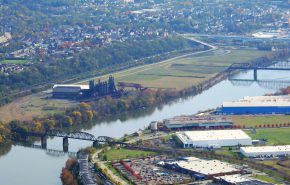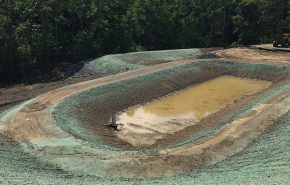Remediating brownfield sites is a formidable venture, but GAI Consultants (GAI) helps private and public sector clients turn potential liabilities into productive assets by resolving permitting, evaluation and design, public perception, and environmental issues.
The industrial history, rivers, and natural settings of Pennsylvania contribute to environmental challenges and opportunities when recycling the remnants of the past through brownfield remediation. Among the dozen or more brownfield sites that GAI has helped develop (see GAI’s Brownfield Project Profiles), we are especially proud to have been part of the first such undertaking by the Urban Redevelopment Authority of Pittsburgh–Washington’s Landing at Herr’s Island, and to have been extensively involved in the award-winning and nationally acknowledged success of Summerset at Frick Park.
Washington’s Landing at Herr’s Island. Herr’s Island was considered unusable in the mid-1970s because its abandoned rail stop and 42 acres along the western bank of the Allegheny River had served the meatpacking and rendering industry for decades, but left an industrial footprint of noxious waste and contaminated groundwater. GAI provided site evaluation, planning, design, and permitting. URA-Pittsburgh received the 1997 Phoenix Award, Public Project Category, for Washington’s Landing—their first brownfield development project.
Renamed Washington’s Landing at Herr’s Island because George Washington “slept here” on Herr’s Island after his raft capsized in 1753.
South Side Works. On Pittsburgh’s South Side, a former Jones & Laughlin (LTV) steel facility (one of three in Pittsburgh), along the Monongahela River, had been reduced to an abandoned 123-acre field. Operating since 1893, the steel plant housed open hearth furnaces and mills. In the 1960s, about 8,500 people were employed at the J&L facility. A mile from downtown Pittsburgh, the riverside brownfield site is now a mixed-use development with a riverfront trail. GAI provided environmental site investigations, Phase I evaluations, and Phase II initial characterization.
Summerset at Frick Park. The 238-acre steel mill slag dump (Nine Mile Run) along the Monongahela River has been transformed into Pittsburgh’s largest and most noteworthy residential development since World War II. The first and most successful new traditional neighborhood development in Pittsburgh, the Summerset at Frick Park community continues to thrive and enhance their surroundings with small parks and walking trails.
GAI served as civil, traffic, environmental, and geotechnical engineer, incorporating original techniques such as on-site soil reuse, a seep interceptor system, pollution control, water-quality manhole structures, and an architecturally-treated form liner for retaining walls.
Regraded more than 20M tons of molten steel byproduct (slag) at Nine Mile Run, and restored the stream to a trout habitat.
Our expertise in brownfield remediation has taken GAI to sites across Pennsylvania, and into Ohio, West Virginia, and Indiana. GAI’s 2012/2013 brownfield projects include the 165-acre Carrie Furnace site depicted in the photo at the beginning of this article. Two existing blast furnaces at this former U.S. Steel Works site were designated National Historic Landmarks. We are also working on the 62nd Street Industrial Park, a riverfront site for melting, forging, annealing, and petroleum product storage since the 1800s; and the 178-acre riverfront brownfield in Pittsburgh’s Hazelwood neighborhood—the site of another former LTV steel facility.
Many states have Brownfield and Voluntary Remediation Programs with specific guidelines, and GAI is actively involved with these programs—currently, in West Virginia and Indiana. Our award-winning professionals interact closely with developers, private industry, redevelopment authorities, and government agencies to revitalize former industrial or commercial property polluted by real or perceived environmental contamination.
Visit our website to learn more about our land development and environmental services in areas of brownfield development.



